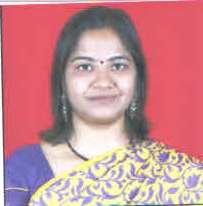Pallavi Shrirang Jamadagni
@ccras.nic.in
Research Officer (Pharmacology)
Regional Ayurveda Research Institute, CCRAS, Min of AYUSH
EDUCATION
M.V. Sc. (Pharmacology and Toxicology)
RESEARCH, TEACHING, or OTHER INTERESTS
General Pharmacology, Toxicology and Pharmaceutics, Veterinary, Biotechnology, Health, Toxicology and Mutagenesis
Scopus Publications
Scopus Publications
Pallavi Jamadagni, Anagha Ranade, Shraddha Bharsakale, Shridhar Chougule, Shrirang Jamadagni, Sharad Pawar, Goli Penchala Prasad, Sudesh Gaidhani, and Arun Gurav
Elsevier BV
Shrirang Jamadagni, Pallavi Jamadagni, Binita Angom, Dhirendranath Mondal, Sachchidanand Upadhyay, Sudesh Gaidhani, and Jayram Hazra
Elsevier BV
PallaviShrirang Jamadagni, SharadD Pawar, ShrirangB Jamadagni, Shridhar Chougule, SudeshN Gaidhani, and SN Murthy
EManuscript Technologies
Holarrhena antidysenterica (L.) Wall. ex A. DC. is a medicinal plant abundantly found in India. Its uses are mentioned in the classical Ayurvedic literature and by many folklore claims. The plant is also of extreme economic importance. Its seeds are mainly used as an antidiabetic remedy. All pharmacological and toxicological aspects of this plant are discussed in this review.
Pallavi Shrirang Jamadagni, Shrirang B. Jamadagni, Arjun Singh, Rajendra Kumar Singh, Sachchidanand N. Upadhyay, Sudesh N. Gaidhani, and Jayram Hazra
Informatics Publishing Limited
Objectives : This study was conducted to estimate No Observed Effect Level (NOEL) or no observed adverse effect level of Swarna Bhasma an Ayurvedic classical preparation of gold in Wistar rats. Materials and Methods : Swarna Bhasma was prepared as per classical Ayurvedic text and analyzed for physicochemical properties. A total of 40 Wistar rats of either sex with an average body weight of 150-200 g were divided into four groups with 10 animals of both sexes in each group. Group I served as control and was given vehicle (Honey:Water in 2:3 ratio) Group II, III, IV were orally administered Swarna Bhasma @ 13.5, 6.75, 1.35 mg/kg body weight for 90 consecutive days. The effect of the drug was observed on ponderal changes, hematological, and biochemical parameters. At the end of the study, all animals were sacrificed and examined for gross pathological changes. Histopathological evaluation was performed only for control and high-dose group and of animals that were moribund sacrificed. Results : Swarna Bhasma was found to be safe at all levels tested. No significant treatment-related clinical signs were noted in all groups studied. The food and water consumption was not affected at highest given dose, i.e., 13.5 mg/kg body weight. No major alterations were observed during histopathological evaluation. Conclusion : This study indicates 13.5 mg/kg body weight as NOEL for Swarna Bhasma in Wistar rats.
P S Jamadagni, S B Jamadagni, M Neogy, R K Singh, S N Upadhyay, and J Hazra
Moksha Publishing House
Punarnava Mandur is an iron containing classical Ayurvedic formulation which was studied for repeated dose oral toxicity study in Wistar rats for 90 days. Total 48 Wistar rats (24 male and 24 female) were selected based on the body weight and were randomly distributed into four groups followed by administration of Punarnava Mandur at the dose of 0, 90, 450, 900 mg/kg body weight for 90 consecutive days. Body weight, Weekly Feed and Water consumption, Clinical Chemistry, Hematology, Differential leukocyte Count, Reticulocyte count and Organ weights were recorded and analyzed statistically. At termination, rats were sacrificed, examined for gross pathological changes, organs were collected, weighed and processed for histopathological evaluation. There was no effect on body weights and feed consumption, no abnormal findings in the histopathological evaluation of high dose group animals but there was significant increase in weight of liver in females of high dose group as compared to control. Hence, the dose level 450 mg/kg of Punarnava Mandur was found as NOAEL (No Observable Adverse Effect Level). However, the NOEL (No Observed Effect Level) could not be established. It was suggested to carry out a toxicity study at possible higher doses so as to establish target organ of toxicity.
Shrirang B. Jamadagni, Pallavi S. Jamadagni, Shannon H. Lacy, Bruce Williams, Sachchida N. Upadhyay, Sudesh N. Gaidhani, and J. Hazra
SAGE Publications
A 12-week-old Swiss Albino mouse was presented with unilateral (left) testicular enlargement of approximately 1.5 cm in diameter and the right testicle mildly reduced in size and weight. Histopathology evaluation revealed three distinct neoplasms in the left testicle: choriocarcinoma, yolk sac carcinoma, and embryonal carcinoma. Teratoma was diagnosed in the right testicle. The histomorphological and immunohistochemical characteristics of the tumor are presented here. To the best of the authors’ knowledge, this is the first report of spontaneous nonmetastasizing choriocarcinoma, yolk sac carcinoma, embryonal carcinoma, and teratoma in testes of a Swiss albino mouse.
S. B. Jamadagni, P. S. Jamadagni, S. N. Upadhyay, S. N. Gaidhani, and J. Hazra
SAGE Publications
A unilateral non-metastatic embryonal carcinoma and teratoma of the testis was observed in a 12-week-old Swiss Albino mouse at the end of a 28-day repeated dose toxicity study. The teratocarcinoma almost completely replaced the parenchyma of the left testis. The tumor was composed of sheets and rosettes of primitive embryonal cells, anaplastic cells, skeletal muscle tissue, sebaceous gland tissue, keratinized stratified squamous epithelium, and ciliated cuboidal epithelium. The histomorphological characteristics of the tumor were reviewed and presented in this report. To the best of the authors' knowledge, this is the first report of spontaneous teratocarcinoma of testis in the Swiss Albino strain of mice.

